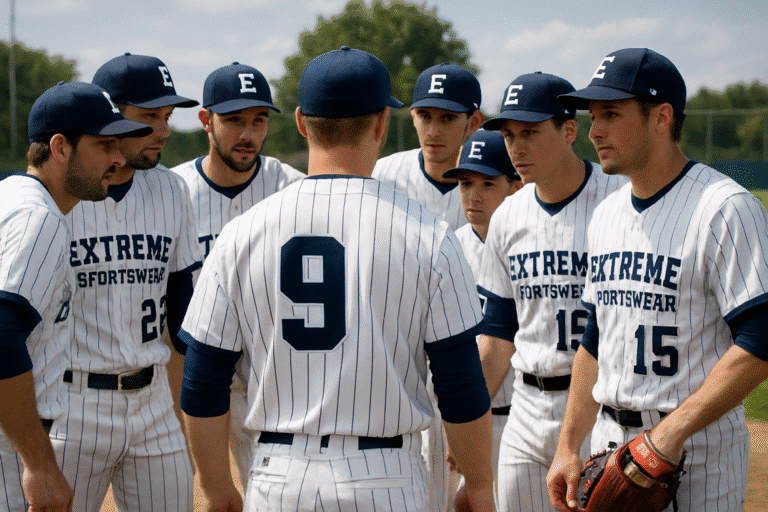
In the high-energy world of sports, sports team uniforms play a pivotal role beyond just identifying players. They represent unity, performance, branding, and even fan engagement. Whether it’s a school team, a local club, or a professional franchise, investing in the right uniform strategy can dramatically impact a team’s image and performance.
This comprehensive guide explores the evolution, significance, design elements, fabric technology, customization, and marketing value of sports team uniforms, along with tips for teams looking to upgrade or create their own.
The Evolution of Sports Team Uniforms
Sports uniforms have come a long way from their humble beginnings. In the early 20th century, uniforms were simple and largely unbranded, made from heavy materials like wool. Their primary purpose was to function, providing coverage and basic team distinction.
Over the decades, the evolution of materials and fashion, coupled with rising commercial interests, transformed uniforms into high-performance, stylish, and highly branded pieces of sportswear. Today’s uniforms are designed with advanced synthetic materials, customized designs, and are often key sources of revenue through merchandise sales.
Why Sports Team Uniforms Matter
Uniforms serve multiple purposes, both practical and psychological:
Team Identity and Unity: A uniform fosters a sense of belonging and equality. Everyone wearing the same design works toward a common goal.
Performance Optimization: Modern sportswear includes moisture-wicking, breathable, and stretchable fabrics that aid performance by enhancing comfort and agility.
Branding and Recognition: Especially for professional and semi-professional teams, uniforms carry logos, sponsors, and color schemes that help establish a brand identity.
Fan Connection: Supporters often wear replicas of team uniforms, making them a critical part of a team’s merchandise strategy.
Fair Play and Regulation: Uniforms also meet league standards for color, number placement, and sponsor visibility, ensuring compliance and professionalism.
Key Elements of a Modern Sports Team Uniform
A successful sports team uniform blends aesthetics, practicality, and regulation compliance. Here are the essential components:
1. Design and Color Scheme
The design should reflect the team’s identity—mascot, location, or ethos. Colors should be distinct yet meaningful. Many teams incorporate local or cultural elements into their design, making the uniform more than just a piece of clothing.
2. Team Logos and Numbers
Proper placement of the team logo, player name, and number is vital. The back number should be large and easily visible, while the front number and name offer additional identification and branding.
3. Fabric and Material
Commonly used fabrics in modern uniforms include:
Polyester: Durable, breathable, and colorfast.
Spandex or Lycra blends: Add flexibility and comfort.
Mesh panels: Improve ventilation and reduce sweat accumulation.
Moisture-wicking materials: Keep athletes dry during performance.
4. Customization Options
Customization is key—names, numbers, and sponsor logos can all be adjusted to suit the team’s needs. Sublimation printing is a popular technique for vibrant, long-lasting prints that don’t peel or crack.
Types of Sports Team Uniforms by Sport
Uniform requirements vary significantly across sports. Let’s explore a few:
1. Football (Soccer) Uniforms
Components: Jersey, shorts, socks, shin guards, and cleats.
Focus: Breathability, lightweight material, and number clarity.
Custom Needs: Sponsor logos, national/team flags, and player names.
2. Basketball Uniforms
Components: Sleeveless jersey, shorts, headbands.
Focus: Flexibility, lightweight material, and sweat-wicking fabrics.
Custom Needs: Large back and front numbers, school or club logos.
3. Cricket Uniforms
Components: Shirt (often with a collar), trousers, caps, and spikes.
Focus: Sun protection (long sleeves), moisture control.
Custom Needs: Country or team name, sponsor logos, player names.
4. Baseball Uniforms
Components: Button-up shirt, pants, cap, socks.
Focus: Fit, durability, and tradition.
Custom Needs: Team emblem, player numbers, and sponsor logos.
5. Rugby and American Football Uniforms
Components: Jersey, padded trousers, helmet (football), boots.
Focus: Tough materials, reinforced seams, and protection gear compatibility.
Custom Needs: Highly durable prints, team emblems, number clarity.
Customization Techniques for Sports Team Uniforms
Customization allows teams to create a unique identity and professional appearance. Here are the main techniques used:
1. Sublimation Printing
Ink is infused into the fabric rather than layered on top.
Perfect for complex designs and vibrant colors.
Durable, breathable, and doesn’t crack or fade.
2. Screen Printing
Ideal for bulk orders with limited color use.
Cost-effective but may not be as long-lasting as sublimation.
3. Embroidery
Used for logos and crests.
Offers a premium look but adds weight and can be less breathable.
4. Heat Transfer Vinyl (HTV)
Used for names and numbers.
Affordable and quick but may peel over time.
Trends in Sports Team Uniforms
Sports uniforms are evolving with the times. Here are some current trends shaping the industry:
1. Eco-Friendly Materials
Sustainability is becoming increasingly important. Brands are offering uniforms made from recycled polyester or organic cotton.
2. Slim Fit and Ergonomic Design
Athletes prefer form-fitting designs that reduce drag and improve range of motion.
3. Tech Integration
Some uniforms now come with embedded sensors that monitor biometric data, aiding in performance analytics.
4. Bold, Non-Traditional Designs
Teams are breaking away from traditional patterns to experiment with abstract, bold, or retro themes to stand out.
Choosing a Sports Team Uniform Manufacturer
Choosing the right manufacturer is crucial to achieving quality, consistency, and timely delivery. Consider the following when selecting one:
Experience and Portfolio: Check previous work to assess quality.
Customization Capabilities: Ensure they offer sublimation, embroidery, and fabric variety.
Turnaround Time: Delivery time matters, especially during peak season.
Pricing and MOQs: Look for transparent pricing and favorable minimum order quantities.
Customer Support: Reliable communication is key for revisions and queries.
Tips for Teams Ordering Sports Uniforms
If you’re a school, club, or semi-professional team looking to order sports team uniforms, keep these tips in mind:
Plan Early: Design and manufacturing take time—order well before your season starts.
Design Mockups: Always request mockups before approving production.
Sizing Charts: Provide accurate sizing charts to avoid fit issues.
Test Samples: Order samples to test fabric quality and design fidelity.
Order Extras: Keep a few extra uniforms on hand for emergencies or new players.
The Business of Sports Team Uniforms
Uniforms are a significant revenue stream for professional sports teams. Here’s how:
Merchandise Sales: Fans buy replica jerseys, shorts, and accessories.
Sponsorship Deals: Prime real estate on jerseys is sold to advertisers.
Branding Campaigns: Uniform changes often accompany new branding efforts.
For local manufacturers, providing quality sports uniforms opens up a huge market in schools, colleges, clubs, and regional teams.
Conclusion: More Than Just Clothing
Sports team uniforms go far beyond aesthetics—they are essential tools for performance, branding, and team spirit. From selecting the right material to customizing designs and choosing the best manufacturer, every decision contributes to how the team looks, feels, and performs.
Whether you are a team manager, a player, or a manufacturer, understanding the intricacies of team uniforms can empower better choices and enhance the sporting experience. Investing in well-designed, high-performance, and customized uniforms isn’t just about looking good—it’s about playing your best, representing your brand, and building a legacy.
